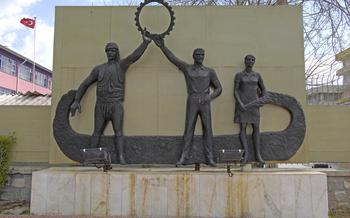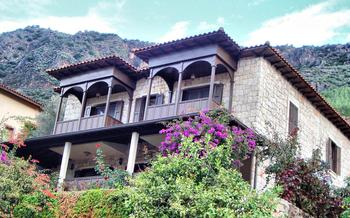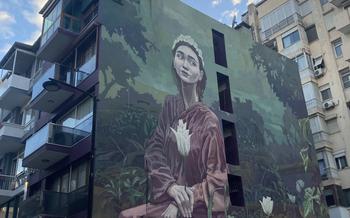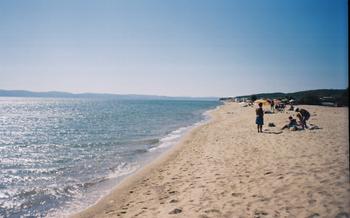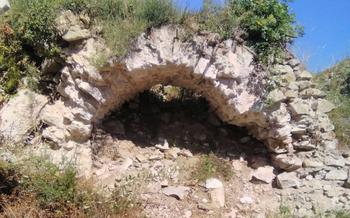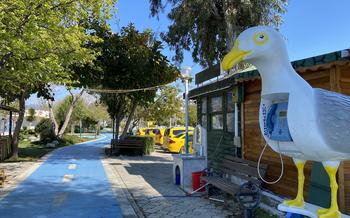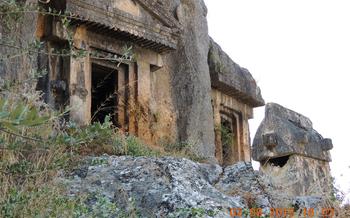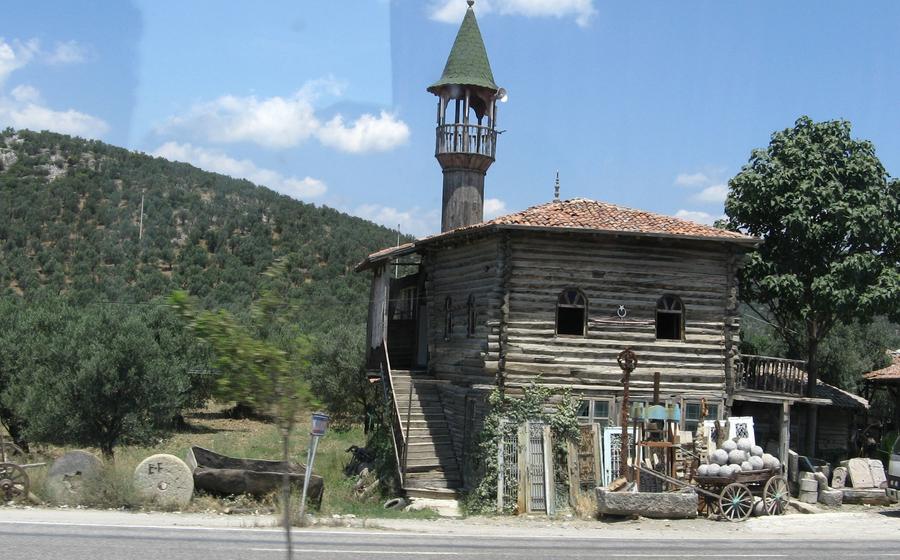
The Ancient City of Lysimachia
- A Journey to Lysimachia:
- Exploring Lysimachia's Ruins
- History and Mythology
- Lysimachia's Architectural Marvels
- Daily Life in Lysimachia
- The Theatre of Lysimachia: A Stage for Ancient Performances
- The Agora of Lysimachia: A Vibrant Marketplace and Civic Center
- The Necropolis of Lysimachia: A Journey into the Afterlife
- The City's Decline and Legacy
- Must-See Highlights
- Tips for Visitors
- Insider Tip:
A Journey to Lysimachia:
In the heart of Balıkesir, Turkey, lies the ancient city of Lysimachia, a testament to the region's rich history and cultural heritage. Founded in the 4th century BC by Lysimachus, one of Alexander the Great's generals, this once-thriving metropolis played a pivotal role in the Hellenistic world. Strategically located on the shores of the Sea of Marmara, Lysimachia served as a gateway between the Aegean Sea and the interior of Anatolia, fostering trade and cultural exchange between diverse civilizations.
The city's origins are closely intertwined with the legacy of Alexander the Great. After his untimely death, Lysimachus emerged as one of the Diadochi, the successors who divided his vast empire among themselves. In 309 BC, he founded Lysimachia as the capital of his Thracian kingdom, choosing this location for its strategic importance and access to the sea. Under his rule, the city quickly grew in size and prominence, becoming a major center of commerce and cultural exchange.
Lysimachia's strategic location made it a hub for trade and commerce. Merchants from across the region and beyond flocked to the city, bringing with them a diverse array of goods and ideas. The city's marketplace (agora) bustled with activity, as traders exchanged everything from agricultural products to luxury items. Lysimachia's vibrant trade also contributed to its cultural melting pot, with influences from Greek, Macedonian, and Persian cultures blending together to create a unique and cosmopolitan atmosphere.
Lysimachia's influence extended beyond its borders, shaping the political and economic landscape of the region. As the capital of the Thracian kingdom, the city played a crucial role in maintaining stability and order in the region. Its strategic location also made it a key military base, allowing Lysimachus to assert his power and influence over neighboring territories.
Exploring Lysimachia's Ruins
Lysimachia's ruins stand as a testament to the city's grandeur and rich history. The massive city walls, with their imposing towers and gates, provide a glimpse into the city's fortifications. Within the walls, the well-preserved theatre is a marvel of ancient engineering, featuring intricate carvings and decorations. The theatre's acoustics are remarkable, allowing performers to be heard clearly from all corners of the auditorium.
Intricate mosaics and sculptures unearthed during excavations offer glimpses of Lysimachia's artistic prowess. These artworks depict scenes from mythology, daily life, and significant historical events. The excavated agora (marketplace) provides insights into the city's bustling commercial center, where merchants from across the region traded goods and ideas. The foundations of shops, administrative buildings, and stoas (covered walkways) are still visible, creating a vibrant picture of Lysimachia's economic and social life.
History and Mythology
Lysimachia's history is steeped in mythology and legend, adding to its allure and mystique. The city's founder, Lysimachus, was a trusted general in Alexander the Great's army, and upon the empire's division after Alexander's death, he inherited Thrace and parts of Asia Minor, establishing Lysimachia as his capital. Lysimachus' reign was marked by both military victories and political challenges, and he eventually met his end in battle.
According to legend, the oracle of Apollo Lykoreios played a significant role in the founding of Lysimachia. The oracle, located in nearby Cyzicus, advised Lysimachus to establish a city on the site where he would see a vision of a deer leading a pack of wolves. Lysimachus followed the oracle's guidance and founded Lysimachia, which flourished under his rule.
The city's location at the crossroads of trade routes and cultural influences led to the adoption of various religious beliefs and practices. Lysimachia's inhabitants worshipped Greek and Roman deities, and archaeological excavations have uncovered evidence of temples dedicated to Zeus, Athena, and Apollo. The city's religious landscape also included local Anatolian cults and the influence of Zoroastrianism, brought by Persian settlers.
Lysimachia's Architectural Marvels
Among the most remarkable features of Lysimachia are its architectural marvels, which showcase the city's ingenuity and artistic prowess. The impressive city walls, constructed with massive stone blocks, stand as a testament to Lysimachia's defensive capabilities. Intricate gates and towers punctuate the walls, providing both security and a sense of grandeur.
The well-preserved theatre is another architectural highlight, showcasing Hellenistic architectural style in all its glory. With its spacious auditorium and intricate carvings, the theatre provided a venue for entertainment and cultural expression. The acoustics of the theatre are particularly impressive, allowing performers to be heard clearly from all corners of the auditorium.
Beyond the city walls, the remains of temples, public buildings, and houses offer insights into Lysimachia's urban planning and architecture. The ruins reveal a sophisticated city with well-organized streets and impressive public spaces. The architectural heritage of Lysimachia is a valuable reminder of the city's significance in the ancient world.
Daily Life in Lysimachia
The ancient city of Lysimachia was a vibrant and cosmopolitan center, with a diverse population and a bustling social and cultural life. The city's inhabitants came from various backgrounds, including Greeks, Macedonians, and Persians, each contributing to the city's unique character and cultural melting pot.
The heart of Lysimachia's daily life was the bustling marketplace, or agora. Here, merchants from across the region and beyond traded goods, ideas, and stories. The agora was a place of commerce, social interaction, and cultural exchange, where people met to buy and sell goods, discuss the latest news, and catch up with friends.
The city's vibrant social and cultural life extended beyond the agora. Lysimachia hosted various festivals, religious ceremonies, and theatrical performances that brought the community together. These events were an essential part of the city's cultural identity and provided entertainment and a sense of belonging to its inhabitants.
Despite the city's prosperity and cultural achievements, life in Lysimachia was not without challenges. The city faced threats from invaders and natural disasters, such as earthquakes. Its inhabitants had to adapt and overcome these challenges to ensure the city's survival and prosperity.
Exploring the daily life of Lysimachia's inhabitants provides a glimpse into the complexities and richness of an ancient city that was home to a diverse and dynamic community.
The Theatre of Lysimachia: A Stage for Ancient Performances
The theatre of Lysimachia stands as a testament to the city's cultural and artistic achievements. With its impressive size and architectural features, it could accommodate thousands of spectators, who gathered to witness a variety of performances and events. The intricate carvings and decorations adorning the theatre's facade and interior showcase the city's artistic talents and craftsmanship.
The acoustics of the theatre are remarkable, allowing performers to be heard clearly from all corners of the auditorium. This acoustic excellence contributed to the immersive and engaging experience of ancient audiences, who were transported to different worlds through the power of theatre.
The theatre served as a central venue for Lysimachia's cultural and religious life. It hosted performances of Greek tragedies and comedies, as well as musical concerts and religious ceremonies. The theatre was also a place for public gatherings and assemblies, where citizens discussed important issues and celebrated civic events.
Attending a performance at the theatre of Lysimachia would have been a captivating experience for ancient visitors. The combination of talented performers, impressive acoustics, and stunning architecture created a truly immersive and unforgettable theatrical experience.
The Agora of Lysimachia: A Vibrant Marketplace and Civic Center
The agora, or marketplace, was the bustling heart of Lysimachia's commercial and civic life. Situated near the city center, it served as a hub for trade, social interaction, and administrative activities. The agora was a rectangular open space surrounded by stoas (covered walkways) lined with shops and stalls. These shops sold a wide variety of goods, from local agricultural products to imported luxuries, catering to the needs of both residents and visitors.
The agora was not merely a place of commerce but also a center for social and civic life. People gathered here to exchange news, discuss politics, and conduct business. It was also the site of religious festivals, public assemblies, and other civic events. The agora's vibrant atmosphere reflected the city's prosperity and its role as a major trading center in the ancient world.
The architectural features of the agora were impressive and reflected the city's wealth and status. The stoas surrounding the agora were adorned with columns, intricate carvings, and colorful frescoes. The stoas provided shelter from the sun and rain, allowing merchants to conduct business and shoppers to browse the goods in comfort. The agora also featured administrative buildings, such as the bouleuterion (council house) and the prytaneion (government building), where officials conducted the city's affairs.
The agora of Lysimachia stands as a testament to the city's economic and social vitality. Its bustling marketplace and lively atmosphere were essential to the daily lives of its inhabitants. Today, the ruins of the agora offer a glimpse into the vibrant commercial and civic life of this ancient city.
The Necropolis of Lysimachia: A Journey into the Afterlife
Outside the bustling city walls of Lysimachia lies an extensive necropolis, a silent city of the dead that holds the secrets of ancient Lysimachian funerary practices and beliefs. Thousands of tombs and funerary monuments dot the landscape, ranging from simple graves to elaborate mausoleums, reflecting the social status and wealth of the deceased.
As you wander through the necropolis, you'll encounter a diverse array of tombs, each telling a unique story. Some are marked by simple headstones, while others feature intricate carvings and reliefs depicting scenes from mythology or daily life. Elaborate mausoleums, adorned with columns, pediments, and sculptures, stand as testaments to the wealth and prestige of the families they once held.
The inscriptions and artwork found on the tombs provide valuable insights into the beliefs and customs of Lysimachia's inhabitants. Epitaphs express grief, love, and hope for the afterlife, while depictions of gods, goddesses, and mythological scenes offer glimpses into the religious beliefs of the ancient Lysimachians.
The necropolis is not merely a collection of graves but a treasure trove of information about Lysimachia's social structure and funerary practices. By studying the tombs and their contents, archaeologists have gained a deeper understanding of the social hierarchy, family relationships, and death rituals of this ancient city.
As you explore the necropolis, let your imagination transport you back in time to the days when Lysimachia was a thriving metropolis. Picture the mourners gathered around the tombs, bidding farewell to their loved ones and entrusting them to the care of the gods. Imagine the rituals and ceremonies that accompanied the burials, and the beliefs that sustained the Lysimachians in the face of death.
The necropolis of Lysimachia is a powerful reminder of the enduring legacy of this ancient city. It is a place where the living and the dead intersect, where the past and the present converge, and where the stories of those who have passed on continue to echo through the ages.
The City's Decline and Legacy
Lysimachia's glory gradually faded after the Roman conquest in the 1st century BC. Several factors contributed to its decline, including devastating earthquakes, invasions by neighboring kingdoms, and shifting trade routes that bypassed the city. As a result, Lysimachia's population dwindled, and its once-thriving economy faltered. The city was eventually abandoned and fell into ruin, becoming a forgotten relic of the past.
Centuries later, in the 19th century, Lysimachia was rediscovered by European travelers and archaeologists. Excavations began in the late 19th century, revealing the city's impressive ruins and providing valuable insights into its history and culture. Today, Lysimachia is a protected archaeological site, attracting visitors from around the world who come to marvel at its well-preserved remains and learn about its rich legacy.
Despite its decline and abandonment, Lysimachia's legacy lives on. The city's ruins serve as a reminder of its former glory and significance, and its contributions to ancient history and culture continue to be studied and celebrated. The preservation and study of Lysimachia's heritage are of utmost importance for understanding the development of ancient civilizations and their lasting impact on the modern world.
Must-See Highlights
Lysimachia's awe-inspiring ruins offer a journey through time, showcasing the grandeur and artistry of this ancient city. Among the must-see highlights are the imposing city walls and towers, standing tall as testaments to Lysimachia's strategic importance.
Stroll along the ramparts, marveling at the massive stone blocks and intricate gates that once protected the city. Ascend the towers to capture breathtaking panoramic views of the surrounding landscape, where the Aegean Sea meets the fertile plains of Anatolia.
Venture into the well-preserved theatre, a masterpiece of Hellenistic architecture. Imagine the vibrant atmosphere as ancient audiences gathered to witness theatrical performances, religious ceremonies, and civic events. Admire the intricate carvings and decorations that adorn the theatre's facade and interior, showcasing the city's artistic prowess.
Discover the exquisite mosaics and sculptures that once adorned Lysimachia's public spaces and private residences. These intricate artworks depict mythological scenes, historical events, and everyday life, offering glimpses into the cultural and artistic achievements of this ancient civilization.
Explore the necropolis, an extensive cemetery located outside the city walls. Wander among thousands of tombs and funerary monuments, ranging from simple graves to elaborate mausoleums. Decipher the inscriptions and admire the artwork found on the tombs, gaining insights into the beliefs, customs, and social structure of Lysimachia's inhabitants.
Tips for Visitors
To make the most of your visit to the ancient city of Lysimachia, here are a few tips to keep in mind:
-
Plan your visit during the spring or fall. The weather during these seasons is generally mild and pleasant, making it ideal for exploring the ruins without the discomfort of extreme heat or cold. Additionally, the crowds tend to be smaller during these times, allowing you to experience the site at a more leisurely pace.
-
Wear comfortable shoes. The ancient city covers a significant area, and you'll be doing a lot of walking on uneven terrain. Make sure to wear comfortable shoes that provide good support to avoid any discomfort or blisters.
-
Bring water and snacks. There are no food or drink options available on-site, so it's important to bring your own water and snacks to stay hydrated and energized throughout your visit.
-
Allow plenty of time to explore. Don't rush your visit to Lysimachia. Take your time to explore the ruins, admire the intricate details, and soak in the historical atmosphere. Allow at least two to three hours to fully appreciate the site.
Insider Tip:
Unravel the Mysteries at the Archaeological Museum in Erdek
Complement your visit to the ancient city of Lysimachia with a trip to the Archaeological Museum in nearby Erdek. This treasure trove of historical artifacts will further enrich your understanding of the region's rich past. Discover a fascinating collection of artifacts excavated from Lysimachia and other nearby sites, including intricate pottery, sculptures, coins, and inscriptions. Immerse yourself in the stories behind these relics and gain insights into the daily lives, customs, and artistic traditions of Lysimachia's inhabitants. The museum's knowledgeable staff is always ready to answer questions and provide context to the exhibits. Don't miss this opportunity to delve deeper into the history and legacy of this ancient city.
